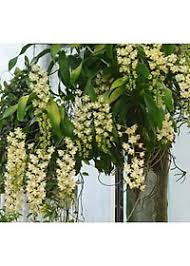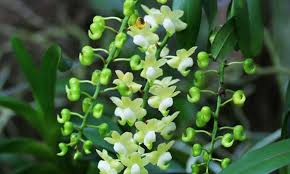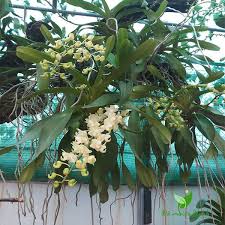
Quế Lan Hương, known scientifically as *Dendrobium anosmum*, is a beautiful and fragrant orchid that brings joy to many plant enthusiasts. However, like all plants, it is susceptible to various pests and diseases that can hinder its growth and diminish its aesthetic appeal. This article will guide you through effective strategies for preventing pests and diseases in Quế Lan Hương, ensuring your orchids thrive in a healthy and vibrant environment.
## Understanding Quế Lan Hương
### Botanical Overview
Quế Lan Hương is an epiphytic orchid native to Southeast Asia, prized for its stunning, fragrant flowers that bloom in clusters. The blooms can vary in color, primarily ranging from white to lavender. To care for these orchids effectively, it is essential to understand their growing conditions and common challenges they may face.
### Common Pests and Diseases
Before discussing preventive measures, let’s look at the most common pests and diseases that affect Quế Lan Hương:
#### A. Pests
1. **Aphids**
– **Description**: Small, soft-bodied insects that suck sap from the plant, leading to stunted growth and distorted leaves.
– **Signs**: Sticky residue (honeydew) on leaves, curling leaves, and presence of ants attracted to the honeydew.
2. **Mealybugs**
– **Description**: White, cottony pests that often hide in leaf joints and on stems.
– **Signs**: Sticky residue, yellowing leaves, and a general decline in plant health.
3. **Spider Mites**
– **Description**: Tiny arachnids that thrive in dry conditions and suck sap from leaves.
– **Signs**: Fine webbing on the plant, stippling or discoloration of leaves.
4. **Scale Insects**
– **Description**: Hard, shell-like pests that attach themselves to the plant’s surface.
– **Signs**: Yellowing leaves, sticky residue, and eventual leaf drop.
#### B. Diseases
1. **Root Rot**
– **Description**: A fungal disease caused by overwatering or poorly draining soil, leading to the decay of the roots.
– **Signs**: Wilting, yellowing leaves, and a foul smell from the roots.
2. **Powdery Mildew**
– **Description**: A fungal disease characterized by a white powdery coating on leaves.
– **Signs**: Leaves may curl, yellow, or drop prematurely.
3. **Botrytis Blight**
– **Description**: A fungal disease that thrives in humid conditions, causing brown, soft spots on flowers and leaves.
– **Signs**: Greyish mold on affected areas, wilting flowers, and leaf drop.
## Preventive Measures for Pests and Diseases
### 1. Choose the Right Growing Environment
The first step in preventing pests and diseases is to ensure your Quế Lan Hương is grown in an appropriate environment.
#### A. Light Conditions
Quế Lan Hương thrives in bright, indirect sunlight. Too much direct sunlight can scorch the leaves, while insufficient light can weaken the plant, making it more susceptible to pests and diseases.
#### B. Humidity and Airflow
These orchids prefer high humidity levels (around 50-70%) but need good airflow to prevent mold and fungal issues. Consider the following:
– **Humidity Trays**: Place humidity trays filled with water and pebbles under your orchids to maintain moisture without waterlogging the roots.
– **Fans**: Use fans to circulate air around the plants, reducing humidity and preventing fungal diseases.
### 2. Implement Proper Watering Techniques
Overwatering is a common cause of root rot and other diseases. Follow these guidelines to water your Quế Lan Hương correctly:
#### A. Watering Schedule
– **Frequency**: Water when the top inch of the growing medium feels dry. This could vary from once a week to every two weeks, depending on environmental conditions.
– **Technique**: Water thoroughly, allowing excess water to drain out of the bottom of the pot. Avoid letting the plant sit in water.
#### B. Quality of Water
Use distilled or rainwater if possible, as tap water may contain chlorine and other chemicals that can stress the plant.
### 3. Choose the Right Potting Medium
The potting medium plays a crucial role in the health of Quế Lan Hương. Use a well-draining medium designed for orchids, such as a mix of bark, sphagnum moss, and perlite. This type of mix allows for proper airflow and drainage, reducing the risk of root rot.
### 4. Regularly Inspect Your Orchids
Routine inspections are vital for early detection of pests and diseases.
#### A. Visual Checks
– **Leaves and Stems**: Regularly examine the leaves and stems for signs of pests (e.g., webs, sticky residue, discoloration).
– **Roots**: When watering, check the roots for signs of rot or discoloration.
#### B. Cleanliness
Keep the growing area clean. Remove any fallen leaves or debris that can harbor pests and diseases. Regularly clean pots and trays to prevent mold and algae buildup.
### 5. Maintain Good Hygiene
Good hygiene practices can prevent the introduction of pests and diseases to your Quế Lan Hương.
#### A. Sterilize Tools
Always sterilize your pruning shears and other gardening tools before and after use. This helps prevent the spread of diseases from one plant to another.
#### B. Quarantine New Plants
When introducing new plants to your collection, quarantine them for a few weeks to ensure they are pest and disease-free before mixing them with your existing plants.
### 6. Use Natural Pest Control Methods
If you notice the presence of pests, consider natural control methods before resorting to chemical pesticides.
#### A. Insecticidal Soap
Insecticidal soap is an effective and environmentally friendly solution for controlling soft-bodied pests like aphids and mealybugs. Spray it directly onto the affected areas of the plant.
#### B. Neem Oil
Neem oil is a natural pesticide that can be used to deter various pests while also having antifungal properties. Dilute neem oil with water according to package instructions and apply it as a foliar spray.
### 7. Monitor and Adjust Nutrient Levels
Proper fertilization can enhance the health of Quế Lan Hương, making it more resilient to pests and diseases.
#### A. Fertilization Schedule
– **Balanced Fertilizer**: Use a balanced orchid fertilizer every few weeks during the growing season (spring and summer). This will provide essential nutrients and promote vigorous growth.
– **Dilution**: Always dilute the fertilizer to half-strength to avoid nutrient burn.
#### B. Signs of Nutrient Deficiency
Be observant for signs of nutrient deficiency, such as yellowing leaves or poor growth. Adjust your fertilization schedule accordingly.
### 8. Protect from Environmental Stress
Environmental stress can weaken plants, making them more vulnerable to pests and diseases. Consider the following:
#### A. Temperature Control
Quế Lan Hương prefers temperatures between 65°F to 80°F (18°C to 27°C) during the day and slightly cooler temperatures at night. Avoid placing them in drafty areas or near heat sources.
#### B. Avoid Overcrowding
Ensure that Quế Lan Hương has enough space between plants to allow for proper airflow. Overcrowding can create a humid environment that encourages fungal diseases.
### 9. Know When to Seek Help
If you encounter persistent pest or disease issues that you cannot manage, consider consulting with a professional horticulturist or pest control specialist who has experience with orchids.
### 10. Educate Yourself on Orchid Care
Stay informed about best practices for orchid care and the specific needs of Quế Lan Hương. Join online forums, local gardening clubs, or workshops to learn from other orchid enthusiasts and professionals.
## Conclusion
Preventing pests and diseases in Quế Lan Hương requires a combination of knowledge, vigilance, and good gardening practices. By creating an optimal growing environment, implementing proper care techniques, and maintaining good hygiene, you can significantly reduce the risk of pest infestations and diseases. Regular inspections and timely interventions will help ensure your Quế Lan Hương thrives, providing you with beautiful blooms and delightful fragrance for years to come. Embrace these practices, and you will cultivate a healthy and vibrant collection of these exquisite orchids, bringing joy and beauty to your home or garden.


